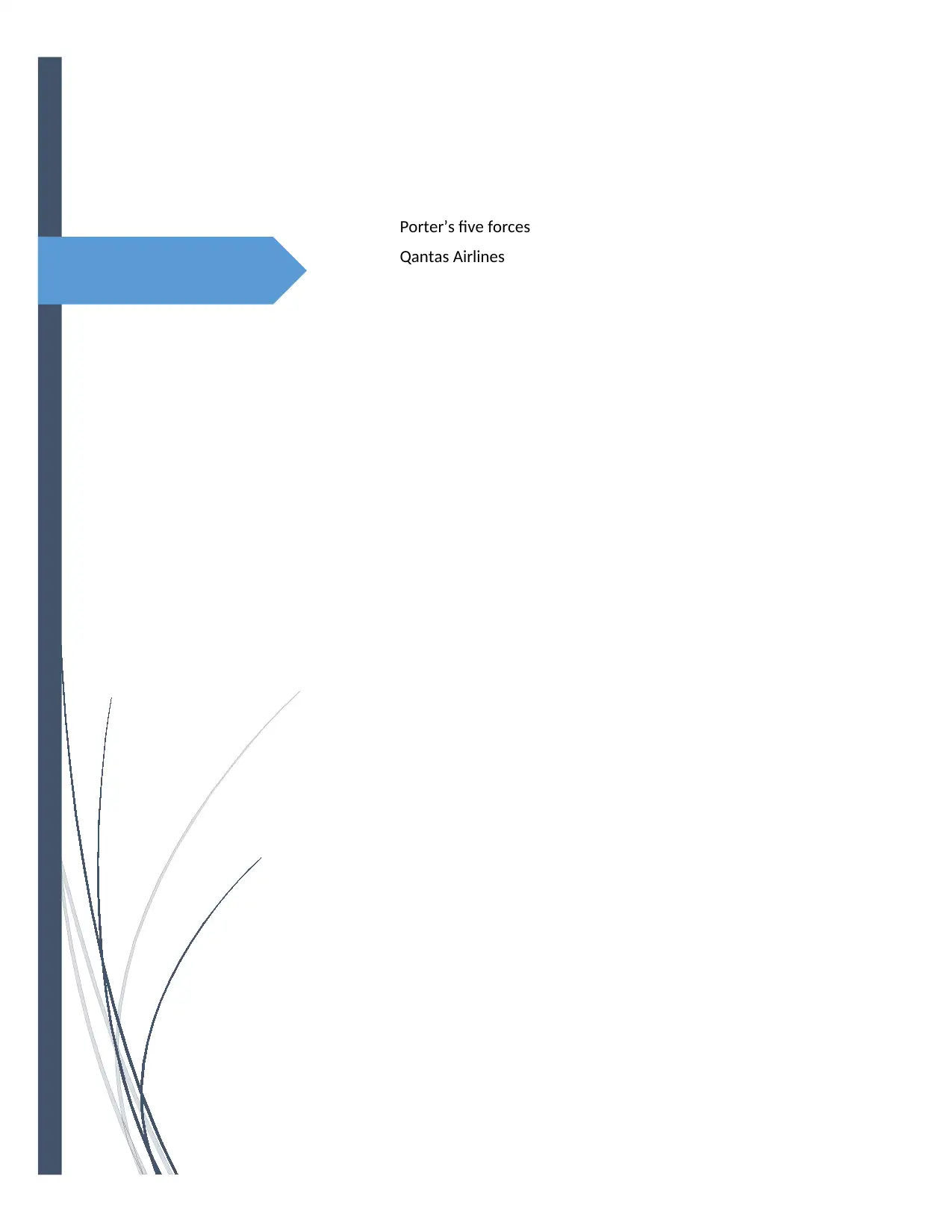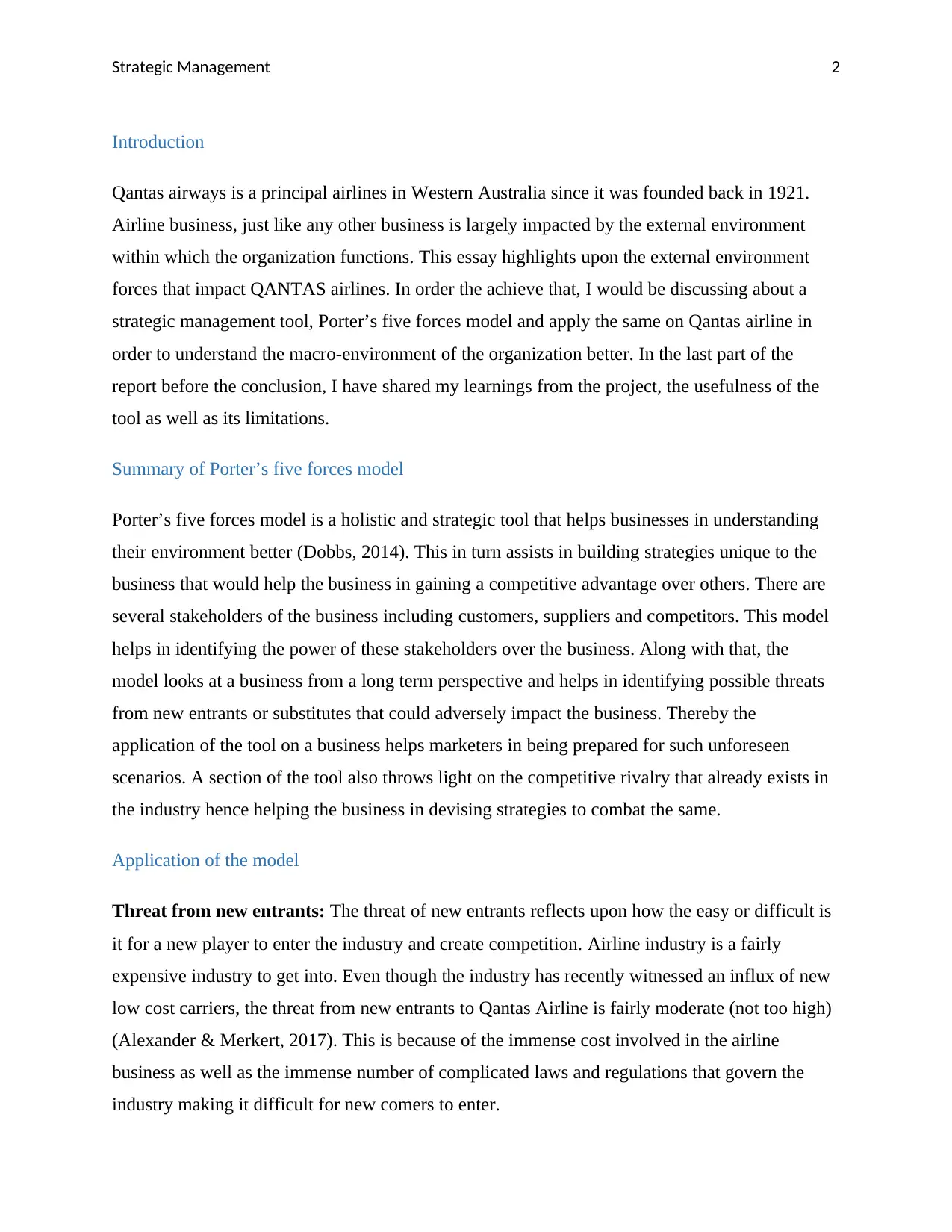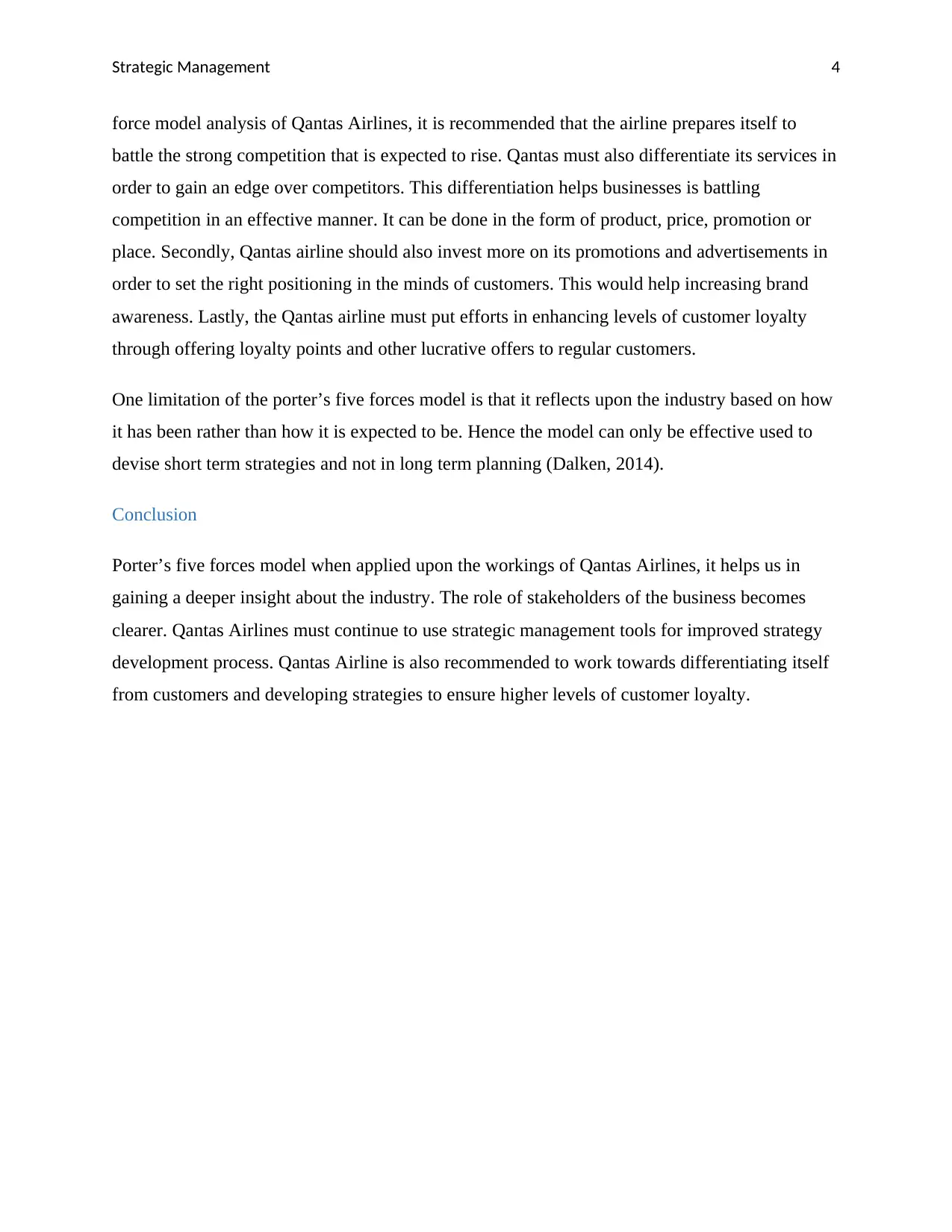Strategic Analysis of Qantas Airlines using Porter's Five Forces
VerifiedAdded on 2023/06/04
|6
|1363
|352
Essay
AI Summary
This essay provides a strategic analysis of Qantas Airlines using Porter's Five Forces model. It summarizes the model and applies each of the five forces—threat of new entrants, threat of substitutes, power of buyers, power of suppliers, and competitive rivalry—to Qantas, assessing their impact on the airline's competitive environment. The essay also discusses the usefulness and limitations of Porter's Five Forces model as a strategic management tool, highlighting its value in understanding industry dynamics and informing strategic decision-making, while acknowledging its limitations in predicting future industry changes. The analysis recommends that Qantas focuses on service differentiation and customer loyalty to maintain a competitive edge in the evolving airline industry. Desklib provides a platform to access this and other solved assignments.

Porter’s five forces
Qantas Airlines
Qantas Airlines
Paraphrase This Document
Need a fresh take? Get an instant paraphrase of this document with our AI Paraphraser

Strategic Management 1
Table of contents
Introduction......................................................................................................................................1
Summary of Porter’s five forces model...........................................................................................1
Application of the model.................................................................................................................1
Usefulness and limitations...............................................................................................................2
Conclusion.......................................................................................................................................3
References........................................................................................................................................4
Table of contents
Introduction......................................................................................................................................1
Summary of Porter’s five forces model...........................................................................................1
Application of the model.................................................................................................................1
Usefulness and limitations...............................................................................................................2
Conclusion.......................................................................................................................................3
References........................................................................................................................................4

Strategic Management 2
Introduction
Qantas airways is a principal airlines in Western Australia since it was founded back in 1921.
Airline business, just like any other business is largely impacted by the external environment
within which the organization functions. This essay highlights upon the external environment
forces that impact QANTAS airlines. In order the achieve that, I would be discussing about a
strategic management tool, Porter’s five forces model and apply the same on Qantas airline in
order to understand the macro-environment of the organization better. In the last part of the
report before the conclusion, I have shared my learnings from the project, the usefulness of the
tool as well as its limitations.
Summary of Porter’s five forces model
Porter’s five forces model is a holistic and strategic tool that helps businesses in understanding
their environment better (Dobbs, 2014). This in turn assists in building strategies unique to the
business that would help the business in gaining a competitive advantage over others. There are
several stakeholders of the business including customers, suppliers and competitors. This model
helps in identifying the power of these stakeholders over the business. Along with that, the
model looks at a business from a long term perspective and helps in identifying possible threats
from new entrants or substitutes that could adversely impact the business. Thereby the
application of the tool on a business helps marketers in being prepared for such unforeseen
scenarios. A section of the tool also throws light on the competitive rivalry that already exists in
the industry hence helping the business in devising strategies to combat the same.
Application of the model
Threat from new entrants: The threat of new entrants reflects upon how the easy or difficult is
it for a new player to enter the industry and create competition. Airline industry is a fairly
expensive industry to get into. Even though the industry has recently witnessed an influx of new
low cost carriers, the threat from new entrants to Qantas Airline is fairly moderate (not too high)
(Alexander & Merkert, 2017). This is because of the immense cost involved in the airline
business as well as the immense number of complicated laws and regulations that govern the
industry making it difficult for new comers to enter.
Introduction
Qantas airways is a principal airlines in Western Australia since it was founded back in 1921.
Airline business, just like any other business is largely impacted by the external environment
within which the organization functions. This essay highlights upon the external environment
forces that impact QANTAS airlines. In order the achieve that, I would be discussing about a
strategic management tool, Porter’s five forces model and apply the same on Qantas airline in
order to understand the macro-environment of the organization better. In the last part of the
report before the conclusion, I have shared my learnings from the project, the usefulness of the
tool as well as its limitations.
Summary of Porter’s five forces model
Porter’s five forces model is a holistic and strategic tool that helps businesses in understanding
their environment better (Dobbs, 2014). This in turn assists in building strategies unique to the
business that would help the business in gaining a competitive advantage over others. There are
several stakeholders of the business including customers, suppliers and competitors. This model
helps in identifying the power of these stakeholders over the business. Along with that, the
model looks at a business from a long term perspective and helps in identifying possible threats
from new entrants or substitutes that could adversely impact the business. Thereby the
application of the tool on a business helps marketers in being prepared for such unforeseen
scenarios. A section of the tool also throws light on the competitive rivalry that already exists in
the industry hence helping the business in devising strategies to combat the same.
Application of the model
Threat from new entrants: The threat of new entrants reflects upon how the easy or difficult is
it for a new player to enter the industry and create competition. Airline industry is a fairly
expensive industry to get into. Even though the industry has recently witnessed an influx of new
low cost carriers, the threat from new entrants to Qantas Airline is fairly moderate (not too high)
(Alexander & Merkert, 2017). This is because of the immense cost involved in the airline
business as well as the immense number of complicated laws and regulations that govern the
industry making it difficult for new comers to enter.
⊘ This is a preview!⊘
Do you want full access?
Subscribe today to unlock all pages.

Trusted by 1+ million students worldwide

Strategic Management 3
Threat from substitutes: The threat of substitutes reflects upon other products or services that
could replace the business offering. Qantas airline is a part of the airline industry. The substitutes
to airlines include other modes of transportation including land and sea. All of the other
substitutes are relatively very time consuming and hence not preferred by customers despite their
lower cost. People take flights to save time. This is why the threat to Qantas Airlines from
substitutes is negligible.
Power of buyers: The customers of Qantas Airline have little or no power as against the airline.
This is because air travel tickets are sold at a fixed price and are non-negotiable. However, with
the advent of increasing competition in the industry, if Qantas does not cater to the needs and
demands of its customers then the airline may lose these customers to competitors (Lohmann,
2018). This is why the airline must consistently strive to improve upon its services and offer
competent prices to survive the competition.
Power of suppliers: Businesses in the airline industry are associated with a large number of
suppliers (Cook & Billig, 2017). Qantas airline has been in the business since 1921 and
continues to have a strong brand name since then. Therefore the suppliers of Qantas Airline have
limited power over the airline because there are a large number of suppliers present in the market
who are often in competition with each other. Suppliers also prefer associating with strong brand
names such as Qantas.
Competitive rivalry: Competitive rivalry refers to the existing competition within the industry.
Gone are the days where countries had limited airlines. Today, the competition in the industry is
high and is expected to soar all the way more. A large number of low cost airlines have entered
the market and made it difficult for existing players. In order to sustain this competition and
excel within the industry, it is recommended that the airline attempts to differentiate itself in
terms of service quality, time of travel, add on services or price.
Usefulness and limitations
Porter’s five forces is a strategic management tool that allows businesses to understand the
industry better and hence helps them in devising strategies for future growth (Tassabehji &
Isherwood, 2014). The model is highly effective and is widely used. Based upon the Porter’s five
Threat from substitutes: The threat of substitutes reflects upon other products or services that
could replace the business offering. Qantas airline is a part of the airline industry. The substitutes
to airlines include other modes of transportation including land and sea. All of the other
substitutes are relatively very time consuming and hence not preferred by customers despite their
lower cost. People take flights to save time. This is why the threat to Qantas Airlines from
substitutes is negligible.
Power of buyers: The customers of Qantas Airline have little or no power as against the airline.
This is because air travel tickets are sold at a fixed price and are non-negotiable. However, with
the advent of increasing competition in the industry, if Qantas does not cater to the needs and
demands of its customers then the airline may lose these customers to competitors (Lohmann,
2018). This is why the airline must consistently strive to improve upon its services and offer
competent prices to survive the competition.
Power of suppliers: Businesses in the airline industry are associated with a large number of
suppliers (Cook & Billig, 2017). Qantas airline has been in the business since 1921 and
continues to have a strong brand name since then. Therefore the suppliers of Qantas Airline have
limited power over the airline because there are a large number of suppliers present in the market
who are often in competition with each other. Suppliers also prefer associating with strong brand
names such as Qantas.
Competitive rivalry: Competitive rivalry refers to the existing competition within the industry.
Gone are the days where countries had limited airlines. Today, the competition in the industry is
high and is expected to soar all the way more. A large number of low cost airlines have entered
the market and made it difficult for existing players. In order to sustain this competition and
excel within the industry, it is recommended that the airline attempts to differentiate itself in
terms of service quality, time of travel, add on services or price.
Usefulness and limitations
Porter’s five forces is a strategic management tool that allows businesses to understand the
industry better and hence helps them in devising strategies for future growth (Tassabehji &
Isherwood, 2014). The model is highly effective and is widely used. Based upon the Porter’s five
Paraphrase This Document
Need a fresh take? Get an instant paraphrase of this document with our AI Paraphraser

Strategic Management 4
force model analysis of Qantas Airlines, it is recommended that the airline prepares itself to
battle the strong competition that is expected to rise. Qantas must also differentiate its services in
order to gain an edge over competitors. This differentiation helps businesses is battling
competition in an effective manner. It can be done in the form of product, price, promotion or
place. Secondly, Qantas airline should also invest more on its promotions and advertisements in
order to set the right positioning in the minds of customers. This would help increasing brand
awareness. Lastly, the Qantas airline must put efforts in enhancing levels of customer loyalty
through offering loyalty points and other lucrative offers to regular customers.
One limitation of the porter’s five forces model is that it reflects upon the industry based on how
it has been rather than how it is expected to be. Hence the model can only be effective used to
devise short term strategies and not in long term planning (Dalken, 2014).
Conclusion
Porter’s five forces model when applied upon the workings of Qantas Airlines, it helps us in
gaining a deeper insight about the industry. The role of stakeholders of the business becomes
clearer. Qantas Airlines must continue to use strategic management tools for improved strategy
development process. Qantas Airline is also recommended to work towards differentiating itself
from customers and developing strategies to ensure higher levels of customer loyalty.
force model analysis of Qantas Airlines, it is recommended that the airline prepares itself to
battle the strong competition that is expected to rise. Qantas must also differentiate its services in
order to gain an edge over competitors. This differentiation helps businesses is battling
competition in an effective manner. It can be done in the form of product, price, promotion or
place. Secondly, Qantas airline should also invest more on its promotions and advertisements in
order to set the right positioning in the minds of customers. This would help increasing brand
awareness. Lastly, the Qantas airline must put efforts in enhancing levels of customer loyalty
through offering loyalty points and other lucrative offers to regular customers.
One limitation of the porter’s five forces model is that it reflects upon the industry based on how
it has been rather than how it is expected to be. Hence the model can only be effective used to
devise short term strategies and not in long term planning (Dalken, 2014).
Conclusion
Porter’s five forces model when applied upon the workings of Qantas Airlines, it helps us in
gaining a deeper insight about the industry. The role of stakeholders of the business becomes
clearer. Qantas Airlines must continue to use strategic management tools for improved strategy
development process. Qantas Airline is also recommended to work towards differentiating itself
from customers and developing strategies to ensure higher levels of customer loyalty.

Strategic Management 5
References
Alexander, D. W., & Merkert, R. (2017). Challenges to domestic air freight in Australia:
Evaluating air traffic markets with gravity modelling. Journal of Air Transport
Management, 61, 41-52.
Cook, G. N., & Billig, B. (2017). Airline Operations and Management: A Management
Textbook. Routledge. United Kingdom.
Dalken, F. (2014). Are porter’s five competitive forces still applicable? a critical examination
concerning the relevance for today’s business (Bachelor's thesis, University of Twente).
2(1), 3. Netherlands
E. Dobbs, M. (2014). Guidelines for applying Porter's five forces framework: a set of industry
analysis templates. Competitiveness Review, 24(1), 32-45.
Lohmann, G., B. (2018). Airline business strategy. The Routledge Companion to Air Transport
Management, 139.
Tassabehji, R., & Isherwood, A. (2014). Management use of strategic tools for innovating during
turbulent times. Strategic Change, 23(1‐2), 63-80.
References
Alexander, D. W., & Merkert, R. (2017). Challenges to domestic air freight in Australia:
Evaluating air traffic markets with gravity modelling. Journal of Air Transport
Management, 61, 41-52.
Cook, G. N., & Billig, B. (2017). Airline Operations and Management: A Management
Textbook. Routledge. United Kingdom.
Dalken, F. (2014). Are porter’s five competitive forces still applicable? a critical examination
concerning the relevance for today’s business (Bachelor's thesis, University of Twente).
2(1), 3. Netherlands
E. Dobbs, M. (2014). Guidelines for applying Porter's five forces framework: a set of industry
analysis templates. Competitiveness Review, 24(1), 32-45.
Lohmann, G., B. (2018). Airline business strategy. The Routledge Companion to Air Transport
Management, 139.
Tassabehji, R., & Isherwood, A. (2014). Management use of strategic tools for innovating during
turbulent times. Strategic Change, 23(1‐2), 63-80.
⊘ This is a preview!⊘
Do you want full access?
Subscribe today to unlock all pages.

Trusted by 1+ million students worldwide
1 out of 6
Related Documents
Your All-in-One AI-Powered Toolkit for Academic Success.
+13062052269
info@desklib.com
Available 24*7 on WhatsApp / Email
![[object Object]](/_next/static/media/star-bottom.7253800d.svg)
Unlock your academic potential
Copyright © 2020–2025 A2Z Services. All Rights Reserved. Developed and managed by ZUCOL.





